It seems we can’t find what you’re looking for. Perhaps searching can help.
Sign Up for newsletter!
Subscribe to get the latest eBook!
Hotline







Over time, the Covid-19 pandemic has greatly damaged the world economy, with significant consequences for investors and business owners across a wide range of sectors, including the wine sector.
Sales of alcoholic beverages have decreased dramatically as a result of the closure of hotels, restaurants, and nightclubs as well as the postponement of big events and festivals.
Despite the global economic issues, eCommerce must be considered among the industries that perform very well. Some companies across multiple areas have enthusiastically embraced eCommerce to weather the downturn.
Also, wine firms follow that wave of change, making eCommerce shine in the new era – the era of digital transformation.
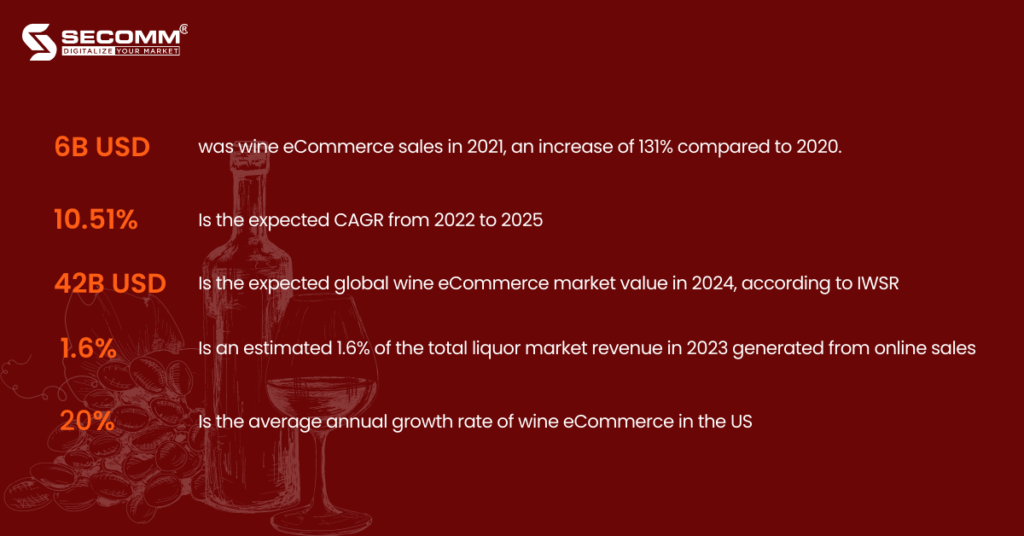
Global Pandemic
In the midst of the global pandemic-related crises, the wine business, like many others, saw a breakthrough in the speed of online purchasing.
When the pandemic breakout occurred, 44% of American consumers placed their first-ever online wine and liquor orders.
The year 2020 saw a 42% increase in wine eCommerce as a result. Online wine sales increased from just $1 billion in 2018 to $6 billion by 2021.
Young wine consumer
In the US, according to Avalara, Millennials and the legal drinking age population are steadily increasing.
By 2023, the Millennial generation is estimated to account for nearly 45% of the LDA (Legal Drinking Age) population under the age of 80. By 2030, this number is projected to be 54%.
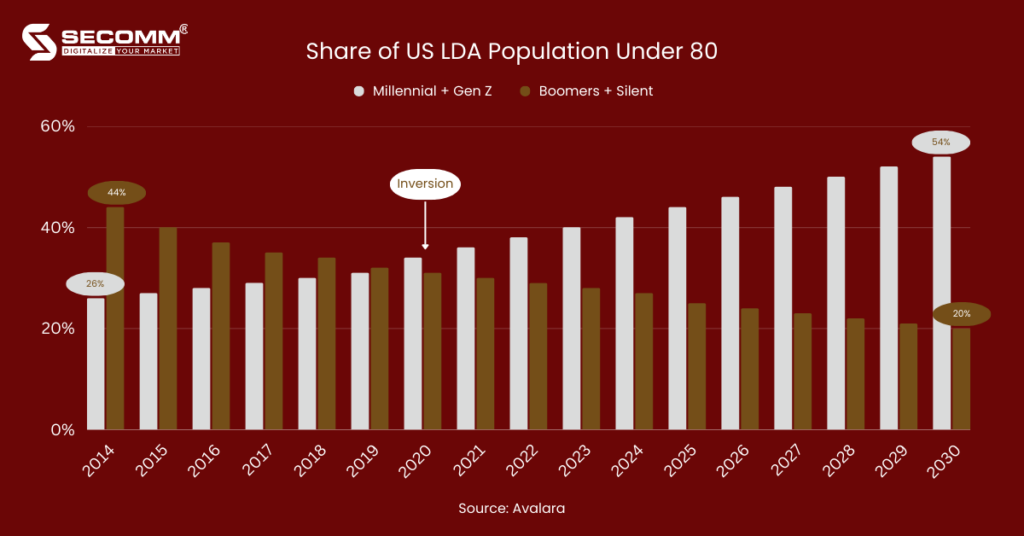
In Vietnam, Millennials (25–38 years old) and Gen Z (18–24 years old), often known as MillennialZ, currently make up 47% of the population or about 45 million people who are of drinking age. The population structure of the MillennialZ generation is expected to keep growing.
The primary factors influencing the growth of the eCommerce sector as well as the digital economy of Vietnam will also be the young people’s awareness of and keeping up with new trends in digital technology compared to previous generations.
The Duty Free Shop Group (DFS) and Changi Airport Group (CAG) collaborated on the iShop Changi Wines eCommerce online project, which offers world-renowned and premium wines and spirits with exclusive discounts to visitors to Changi Airport, particularly those who are CAG members.
The iShop Changi Wines website is cutting-edge and exquisitely styled, showcasing the distinctive qualities of the wine industry as well as the aesthetics from page layout, color, font text, logo, and banner, all of which are guaranteed to optimize the purchasing experience while also, and this is crucial, emphasizing the identity and brand-development elements for both CAG and DFS.
Due to the fact that this is a project of well-known companies, the iShop Changi Wines website has consistently received a lot of traffic, averaging approximately 592 thousand views each month since its introduction.
Therefore, to combat the unexpected surge in traffic and orders during the busiest shopping seasons of the year, the eCommerce system must be continually enhanced and optimized.

The fact that major corporations CAG and DFS both started and developed successful wine eCommerce websites shows the enormous potential of this industry now and in the future.
Previously, the business scope of wine businesses was quite limited, but now that limit has been broken thanks to the dominance of the Internet and the rise of eCommerce.
Moreover, the government’s assistance in lowering legal restrictions has given wine producers the assurance to confidently market their goods to a significant number of potential buyers in several nations across the world.
The Warehouse, established in 2001, is renowned as a top supplier of wines and spirits in Vietnam, offering more than 16 different varieties of wine from numerous nations.
In addition, along with Annam Gourmet Market, Yves Rocher, and Flormar, this is another well-known retail brand of the Nam Group. Before being formally put on the market, products at The Warehouse are consistently inspected and carefully chosen to fulfill quality criteria.
The company has so far increased the reach of its distribution network across the nation, including Ho Chi Minh City, Hanoi, Da Nang, Nha Trang, Hoi An, Quang Ninh, and Phu Quoc.
The Warehouse achieved its objective of serving the wine market with B2B and B2C business models by utilizing the Magento platform.
This implies that the business will broaden the retail channel to include private customers in addition to distributing wines to restaurants, hotels, resorts, pubs, and lounges.
A series of symbols, logos, and banners created especially to fit the characteristics of the wine industry are combined with Bordeaux red to create a website interface that is focused on UI/UX perfection.

The Warehouse is flexible, secure, and has quick ordering, payment, and delivery options. Therefore, customers can place orders through phone, mobile app, or eCommerce website.
Customers can then pick up their purchases from the store or, in major cities like HCM, Hanoi, and Da Nang, the company will deliver them quickly within 2 to 3 hours. In other places, conventional courier delivery takes 2 to 5 days.
The Warehouse has been successful in raising brand recognition, expanding its customer base, and increasing both offline and online sales as a result of the timely growth of its business model and digital transformation
Long-standing Australian company Trentham Estate Winery, founded in 1988, focuses on the manufacture and distribution of wine.
After many years in business, the company is well regarded for its creativity in the wine-making process, which resulted in a variety of wines with different delicious flavors. Also, the brand has received hundreds of medals, titles, and other industry awards.
In the beginning, the business created and ran a WordPress website system for branding purposes.
Trentham Estate, however, has been forced to increase its company scale by making a substantial investment in an entire eCommerce website system due to the growth of eCommerce and the increasingly varied purchasing needs of potential clients.

In the beginning, the business created and ran a WordPress website system for branding purposes. Trentham Estate, however, has been forced to increase its company scale by making a substantial investment in an entire eCommerce website system due to the growth of eCommerce and the increasingly varied purchasing needs of potential clients.
That is what led to the creation of the website trenthamestate.com.au, which has a modern interface while still accurately capturing the distinctive features of the wine industry.
Similar to The Warehouse, Trentham Estate likewise creates an eCommerce website based on the Magento platform with a variety of features that satisfies eCommerce requirements and wine industry specifics.
Therefore, businesses can access and serve a wide range of large customer files not only in Australia and internationally thanks to effective marketing and branding strategies, towards a sustainable business model along with the changes of the digital age.
It would be hard to believe that an industry as sensitive as wine could be traded online so easily and efficiently. In that efficiency and convenience, there is a great contribution of the trend of eCommerce and the comprehensive National Digital Transformation program that is committed to supporting by the Government. This is an extremely appropriate time for wine businesses to confidently deploy eCommerce because of the support from the Government and the push from the market.
However, planning to implementation are two completely different categories. Businesses are required to have a practical strategy and technical assistance from highly skilled firms to hasten the success journey and help advance the National Digital Transformation goal.
SECOMM has many years of expertise in effectively executing eCommerce for numerous customers in various countries. We specialize in offering free consultation services with qualified eCommerce implementation solutions.
Contact us right away for free counsel and assistance.
 2
2
 4,893
4,893
 0
0
 1
1
When the Prime Minister approved the “National Digital Transformation Program to 2025, with a vision to 2030,” national digital transformation became formally a goal shared by the entire Vietnamese people in 2020.
Since then, localities, ministries, branches, and even the government have all gradually incorporated the term “Digital Transformation” and applications of digital technology into their everyday activities.
Thus, we all realize the significance and impact of the digital transformation trend. What essential elements, nevertheless, determine the National Digital Transformation Program’s success or failure?
The process of using digital technology to completely alter each person’s lifestyle, each company’s business model, and each nation’s government operations in order to create new values and prospects for future development is referred to as transformation, also known as digital transformation.
Today, all businesses, big and small, have to decide whether to embrace innovation or risk lagging behind, becoming ineffective, and going out of business.
Furthermore, digital transformation involves- not just comprehending and utilizing technology but, more importantly, reinventing the complete business strategy as well as the vision and development priorities of the nation in relation to the global development trend.
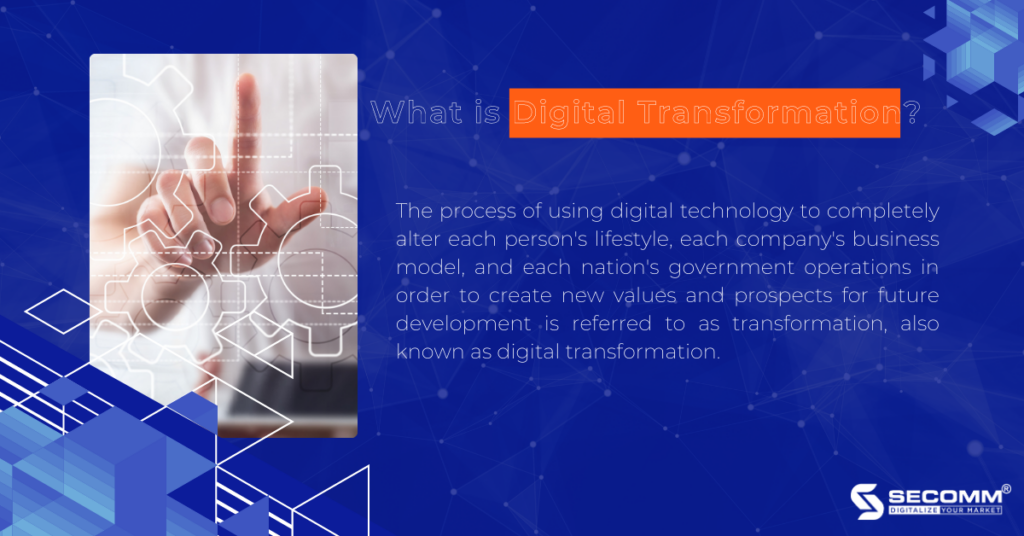
According to data from Mordor Intelligence, the digital transformation age is shining in practically “every nook” of the global economy, confirming that this is not a “soon to fade” trend but rather a new and sustainable development orientation following the pandemic crisis.
In Vietnam alone, the government has established a National Digital Transformation Program for 2025, with a vision to 2030, with particular targets to shorten the distance with other countries around the world, including:
The fact that the goals are stated in great detail in the national digital transformation program with a focus on 2030 demonstrates how seriously the Vietnamese government takes the significance of digital transformation for the prosperous growth of the nation.
Think about the global Industrial Revolution 4.0 wave that is currently in motion. With the aid of connection provided by the Internet of Things (IoT), real-time data access, and the introduction of cyber-physical systems, the Industrial Revolution 4.0, also known as Industry 4.0, primarily focuses on advancing modern digital technology to an entirely new level.
Every Government, organization, corporation, and individual throughout the world must transform its business model, and the manner of working from non-digital to digital operation, in order to keep up with this current technology and immerse itself in the Industry 4.0 wave. The name of this procedure is “digital transformation”.
Vietnam, despite having a minor economy compared to other countries, is a crucial part of the massive Industrial Revolution 4.0 that is currently underway. Vietnam must therefore undergo a digital transformation in order to compete.
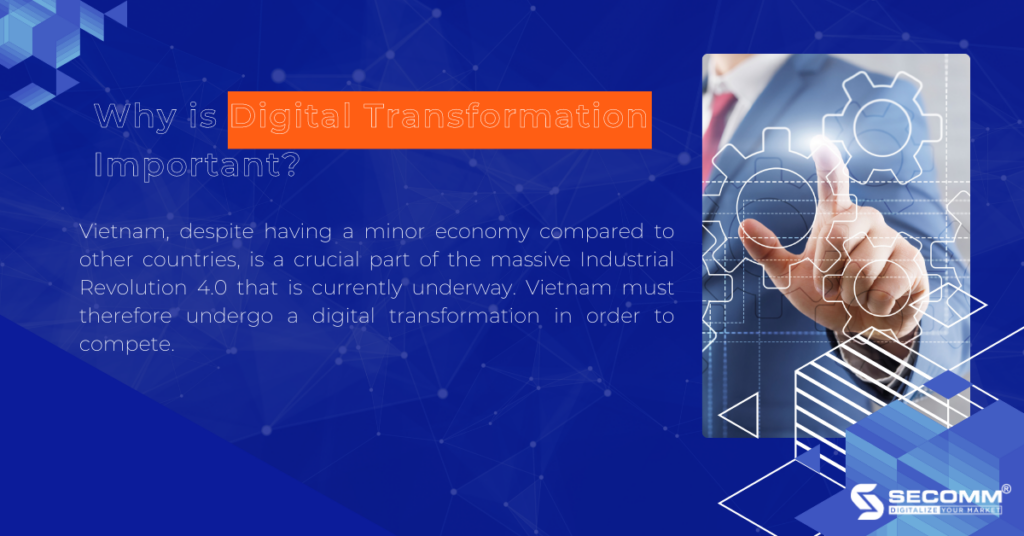
The goal will be challenging to accomplish if just businesses execute digital transformation because the capital and costs are quite high; therefore, businesses require assistance from the government budget and outside finance.
On the other hand, even with a massive budget, it can be challenging for businesses to implement effective digital transformation if the government does not go digital, but continues to run in the old manner, handles administrative procedures slowly, lacks direction, and supports businesses clearly and methodically.
Furthermore, without the support of the people, the National Digital Transformation process to catch up with the global Industry 4.0 wave will be impossible. However, the public needs the government to inform, direct, and inspire digital transformation.
Also, businesses must create useful digital transformation strategies that both before and after implementation considerably raise people’s quality of life.
Vietnam must structure three main areas of digital transformation: the government, businesses, and people, or in other words, the digital government, digital economy, and digital society, if national digital transformation is the outcome it seeks to achieve in order to gradually join the Industrial Revolution 4.0.
These three crucial overlapping and interdependent relationships make up the National Digital Transformation.
Throughout the earlier years, Vinasa reports that in 2019, 40.6% of organizations and businesses confirmed that they have resources available for digital transformation and that 23.6% of them are putting it into practice. However, 30.7% of them are uncertain of what to do despite doing some research, and 38% are unsure of where to begin.
Due to the Prime Minister’s approval of the “National Digital Transformation Program to 2025, with a vision to 2030” and the abrupt change brought on by the impact of the global pandemic, Digital Transformation is now regarded as the process’ starting year. This makes it a top priority to maintain Vietnam’s economy.
The government and Vietnamese enterprises have been able to promote awareness of the importance and urgency of digital transformation in order to help the country overcome the obstacle thanks to the economic crisis brought on by the effects of the Covid-19 outbreak.
According to the UN, Vietnam’s digital government statistics are better than the average for the area. Vietnam specifically saw a rise of 2 places in 2020, moving up to rank 86th out of 193 UN member states globally and 6th out of 11 Southeast Asian nations.
The establishment of the National Digital Transformation Committee and the decision to appoint October 10 of each year as National Digital Transformation Day in accordance with the National Digital Transformation policy for a better life for the people are two additional significant events that will forever be remembered in Vietnam in the years 2021 and 2022.
As a result, leaders and people are more conscious of the significance, function, and advantages of digital transformation, and there are coordinated actions throughout the entire system, from the government to the general populace.
According to data from the Ministry of Information and Communications, the databases that Vietnam has built up to the second quarter of 2022 include:
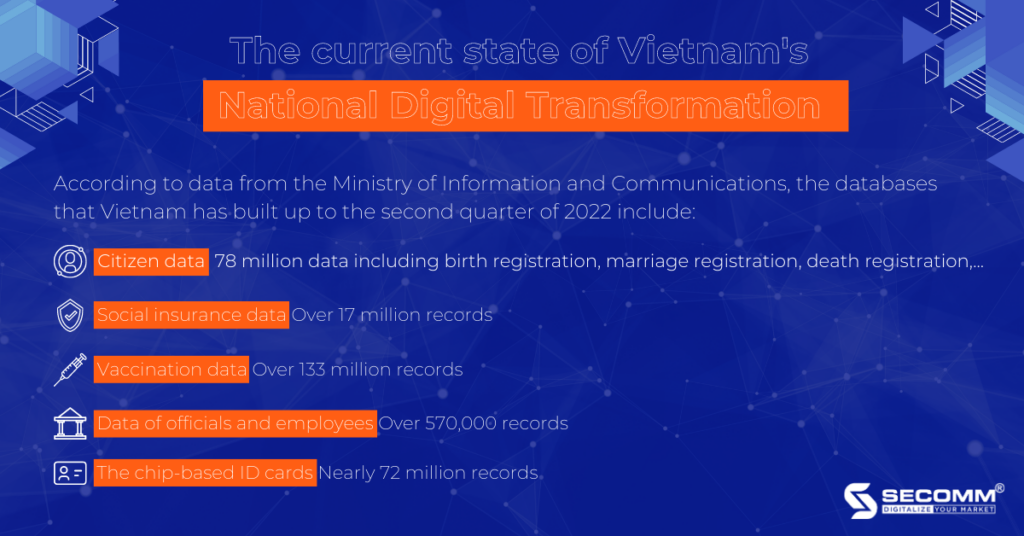
Additionally, the percentage of qualified online public services offered to individuals and enterprises has surpassed 97.3%; the percentage of these services that produce dossiers has gotten to 67.8% and the percentage of administrative procedures handled online has gotten to 43.2%.
Moreover, the economic sector has seen some very good improvements as a result of digital transformation. The Ministry of Information and Communications predicts that by the first quarter of 2022, the value of Vietnam’s digital economy will be 53 billion USD and that there would be 500 more newly founded digital technology businesses than there were at the same point in 2021.
The number of monthly users on Vietnamese mobile digital platforms climbed by more than 100 million compared to the same period in 2021, and the percentage of the digital economy in GDP increased to 10.41% in the first half of the year from 9.6% in the end of 2021.
Based on specific analysis and data on the situation of National Digital Transformation in Vietnam, it is clear that there are 3 main pillars that lay the foundation for the success of the National Digital Transformation process: Digital Government, Digital Economy, and Digital Society.
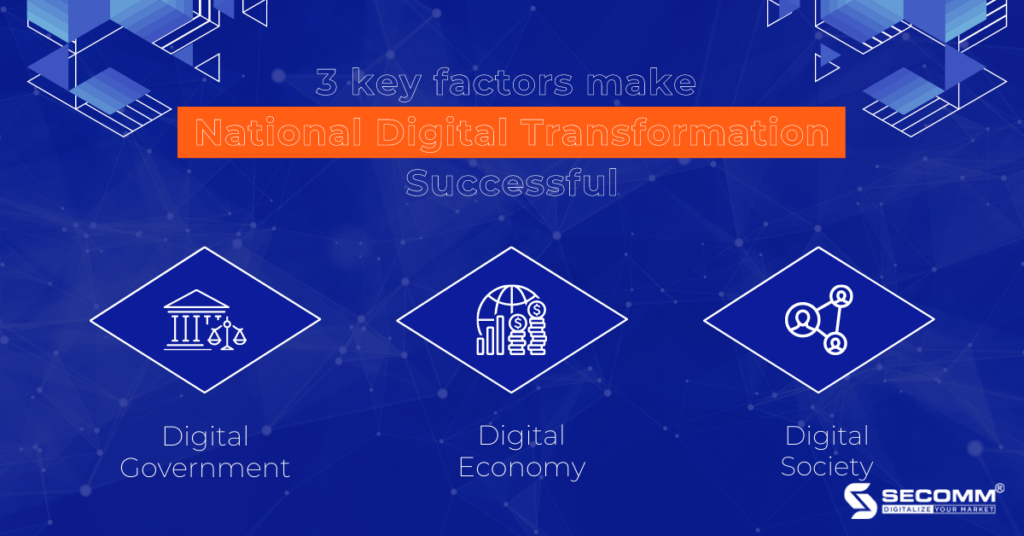
In order to increase operational efficiency and develop new operating models and alter the way services are offered using digital technology and data, a government must transition all of its operations to a digital environment. This allows enterprises to take part in the service delivery process. In other words, this is how the government is becoming digital.
Vietnamese citizens have been instructed in the past to finish the registration processes necessary to access the Citizen Identity Card with a chip, which is gradually replacing the previous ID card. This serves as one illustration of how well the digital government is progressing in Vietnam.
The process of processing dossiers and issuing ID Cards in the early stages is not really effective because the National Database on Civil is still under construction and staff training on how to use digital technology and digitize paper data on the data system is still limited. However, the procedure for issuing chip-based ID cards in addition to the cost is public and transparent.
As a result, when people arrive at the location where the chip-based ID card is made, processing will go more quickly if their information is already in the National Database; otherwise, they will need to provide more birth certificates and household registration information and will have to wait a long time for staff to check, enter data, and complete related procedures.
After that, the chip-based ID card will be sent to the registered address by post, but for the above reason, this process also takes quite a while.
The Public Service Portal of the Ministry of Public Security, however, is currently supported by the government and simply requires people to visit the location to capture pictures and fingerprints.
This demonstrates the government’s prompt responsiveness in streamlining business procedures while also saving time for both citizens and employees. This is evidence of the Government’s ongoing attempts to modernize itself digitally.
In addition, on the CCCD chip, more than 14 information fields of citizens are stored: (1) CCCD number; (2) Full name, other names; (3) Date of birth, month, and year; (4) Gender; (5) Nationality; (6) Ethnicity; (7) Religion; (8) Hometown; (9) Place of permanent residence registration; (10) Identification characteristics; (11) Date of issue; (12) Expiration date;
(13) Full name of parent, spouse; (14) issued 9-digit ID card number; (15) Portrait photos; (16) Features of fingerprint extraction and selection of two index fingers; backup for iris images, and other information.
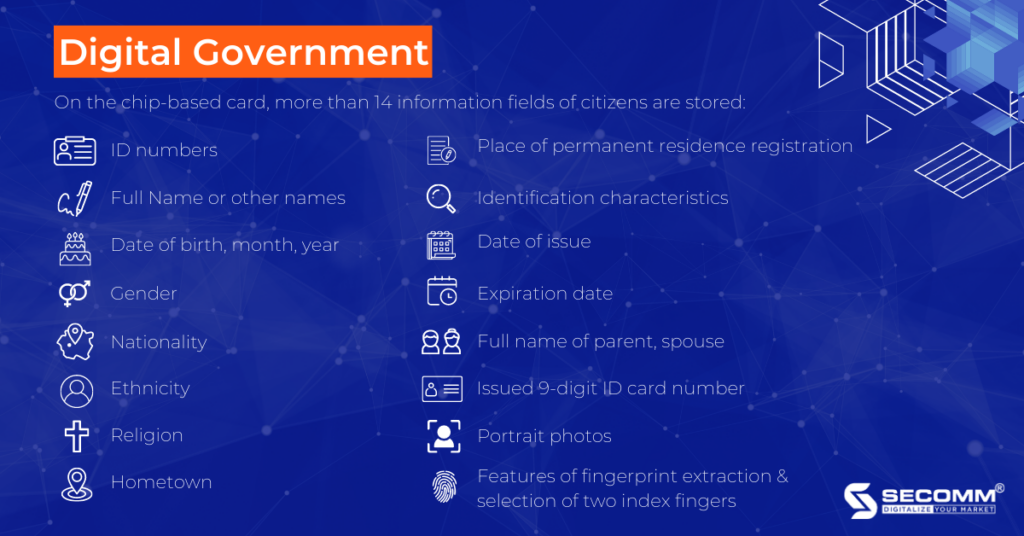
Moreover, a chip-based ID card can replace important papers such as Identity Cards, Health Insurance (HI), Social Insurance (Social Insurance), Birth Certificate, Marriage Certificate, and Household Registration Books….
It is clear that switching from conventional ID cards to chip-based ID cards has several advantages for both the general public and the government. People’s personal information is highly secure, preventing the creation of fake documents.
Also, ID cards with chips make paperwork and transactions straightforward because many pieces of crucial information are combined onto a single card, saving time and preventing the scenario where someone forgets to bring the necessary paperwork and causing the processing of documents to be interrupted.
The government made a wise choice by implementing chip-based ID cards.
The government can save, control, and check information about a specific individual quickly and efficiently with the use of chip-based ID cards and the National Database, helping to effectively control the situation of local security and order as well as national security.
Also, this helps free up labor for government employees who deal with people, handle paperwork, and maintain correctness, speed, and synchronization.
The second factor that makes the success of the National Digital Transformation process is the Digital Economy.
Digital Economy is an economy that maintains and develops constantly based on modern digital technology. The digital economy is also known as the Internet Economy, the New Economy, or the Web Economy. This particular economy is made up of electronic transactions over the internet.
According to the definition from the Vietnam Private Economic Forum, the digital economy is all economic activities based on digital platforms. Digital economy development is the use of digital technology and data to create a new model of cooperation and business, in line with the development trend of modern technology.
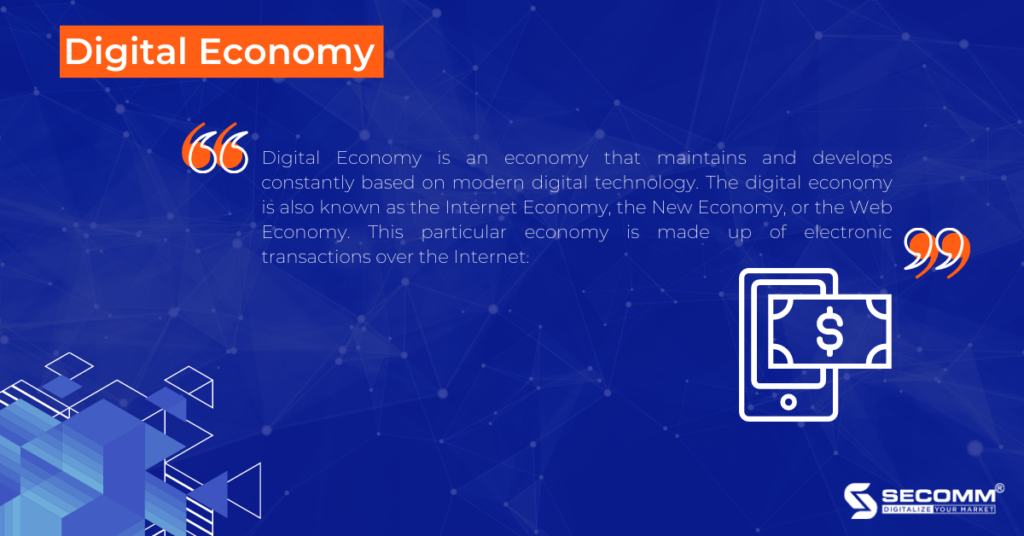
Therefore, everyone would immediately think of eCommerce when discussing the digital economy or the most prominent business model of the trend of digital transformation, and the strong push that this industry provides for high-volume industries catches the trend of digital transformation.
Few people anticipate that the conventional market model, which has become ingrained in Vietnamese culture, would soon be replaced by the market model 4.0, which accepts cashless payments. In several of Hai Phong’s traditional markets, this novel method of buying and selling was introduced for the first time, to the delight of the locals.
The Viettel Money application of Viettel Military Telecom Group, a pioneer in the digital transformation of market 4.0 models in 63 provinces/cities, enables all small businesses and individuals to purchase and sell things at the market by scanning QR codes or transferring money via phone number.
Moreover, cashless payment makes it easier for customers to shop at the market without worrying about issues like carrying change or budgeting extra cash for purchases. Also, many shopkeepers in the market are afraid of this issue pretty much.
Previously, if customers paid in cash with a denomination that was too big, shopkeepers would have to run everywhere to change money, causing time-consuming for both parties and other customers waiting to be served, the issue is now solved with just one smartphone.
Following the success of Hai Phong’s 4.0 market model, many other localities have also implemented this model and received positive feedback signals from the people such as Da Nang, Quang Ninh, Thai Nguyen, Lang Son, etc.
The market 4.0 model has spread to every nook and cranny of the nation’s small trading places, including farmers’ markets, grocery stores, sidewalk shops, amusement parks, parking lots, and more.
The digital transformation trend has quickly extended to places where it was previously impossible, helping to advance the digital economy and achieve the objective of a comprehensive national digital transformation.
Finally, the term “digital society” refers to all human activities in a broad sense. Digital technology, which is based on the exponential growth of information and data, is the primary driver behind digital society.
It transforms all facets of social structure, from the government and business to the individual. In a limited sense, “digital society” refers to both digital citizenship and digital culture.
From this perspective, the three pillars of a digital nation are the digital society, the digital government, and the digital economy.
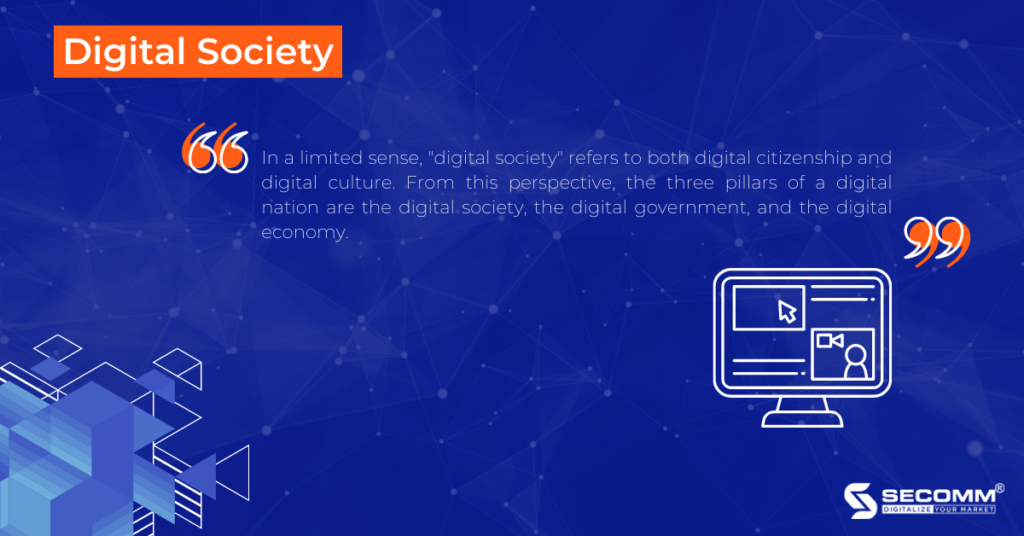
Teachers, parents, and students all adore the eLearning model, which is developing into a popular teaching and learning trend, especially in light of the recent pandemic and widespread implementation of social distancing policies.
Students can access lessons at any time, studying at home, using simply an electronic device with an Internet connection. As a result, teachings can be discussed and interacted with by professors and students without them having to actually meet.
This model also supports student doing teamwork well because it is not time- or space-constrained, saving on travel expenses in addition to using many other helpful resources.
However, for eLearning to really replace traditional teaching and learning methods, it takes a lot of effort from both the Government, the school system, and the student’s parents.
In fact, eLearning is only a small part of the digital society effort besides many other important aspects of society that need to be digitally transformed to make life more convenient for people.
National Digital Transformation has become one of Vietnam’s top goals and this is also a rare project that has received special attention from the highest levels of leadership and international support. Since then, Vietnam has had a full foundation to hope to realize the goal of becoming a digital country from now to 2030.
The development of a digital society, economy, and government, in particular, is a necessary and sufficient condition for a successful national digital transformation.
In fact, every citizen, from intellectuals to regular citizens, is gradually demonstrating a certain understanding in their own way about the digital transformation and awareness that the country is in a transition period to match the general development trend of the times.
This is in addition to the efforts of businesses and the support from the government.
Especially for businesses, digital transformation is an imperative remedy to withstands to withstand the tsunami of eradication brought on by the pandemic’s rapid shift in new business patterns.
Following Covid-19, business digital transformation flowed slowly, gently, and steadily, assisting the economy’s continued rotation.
The first step of the digital transformation journey for businesses is to start implementing eCommerce.
With many years of experience in successfully implementing eCommerce for many customers in many countries, SECOMM specializes in providing consulting services with comprehensive and professional eCommerce implementation solutions.
Contact SECOMM today for free support and advice.
 2
2
 4,171
4,171
 0
0
 1
1
Digital transformation is a necessary process for traditional business models to keep pace with technologies and times. Implementing DT that is suitable for each of the businesses will increase its competitiveness in the market, thereby increasing revenue while optimizing the operation process, creating values for corporate culture and human resources. A complete DT model is a three-layered design: data, process, and business model.
The data layer is necessary to digitize data sources by using technologies for easy-management. A business will implement transformative strategies for operational processes based on transformed data in the process and model layer. Companies can change their models to suit the prolonged orientation and develop corporate culture more extensively. They can also conduct step-by-step or simultaneously implement all the layers if there is a suitable option with the business requirements and specific transformation strategies in both the short and long-term.
Data digitization is transforming from paper-works to digital formats and then storing the digital database in computerized data management systems. Those systems are made up of the technology-implementation to store data intelligently, making data retrieval more manageable and faster. Therefore, data becomes more proactive and brings substantial value-in-use to the business.
Data digitization will create a more seamless working process while ensuring strictly systematic and complete data sources, building a comprehensive digital infrastructure for businesses. It simultaneously is the digital transformation process’s kernel, forming the foundation for all the remaining layers. Up to now, data digitization is an optimal solution ensuring the integrity and security of data systems in the long run, which significantly reduces operating costs.
Additionally, database management systems are the most critical archives that can maximize data access and exploitation efficiency. MySQL is an excellent example among the most popular DMS today, owning multiple useful features based on open source code while ensuring data speed and safety, even large-capacity data systems in the ecommerce field. Accompanying other DMS such as SQL Server, Oracle, PostgreSQL, MySQL can meet most of the data-usage requirements of storage performance, security, and data-safety standards.
These outstanding advantages help MySQL get more appreciation from technological experts by implementing them in many highly-complex technology industries.
Based on the digital data’s core, the process and business model digitalization form a more widespread layer covering the core inside. This classification is highly complex and embraces various forms depending on the operations’ ways and objectives. PMD refers to the transformation relying on technology infrastructures and digital data frameworks to form a digital platform.
To complete the digitalization is to analyze issues in operating processes and business models. From an in-depth analysis, they can provide the right direction and strategy for transformation decisions. This transformation layer has supported businesses to meet the DT requirements, which fully are:
At the same time, a business needs to combine digital solutions to create customer values and build operating models.
Currently, businesses have successfully applied CRM platforms or ERP systems to optimize operational processes in terms of time and resources. It is well-known management platforms such as Zoho CRM, Microsoft Dynamics CRM, or Salesforce CRM that almost all businesses implement for stable development. Those names are tremendous supporting tools to create the business departments’ continuity of processes and operational processes.
Both CRM or ERP systems effectively help businesses achieve targeted sales and effectively disentangle complex manual processes or issues related to data controllability and preservation.
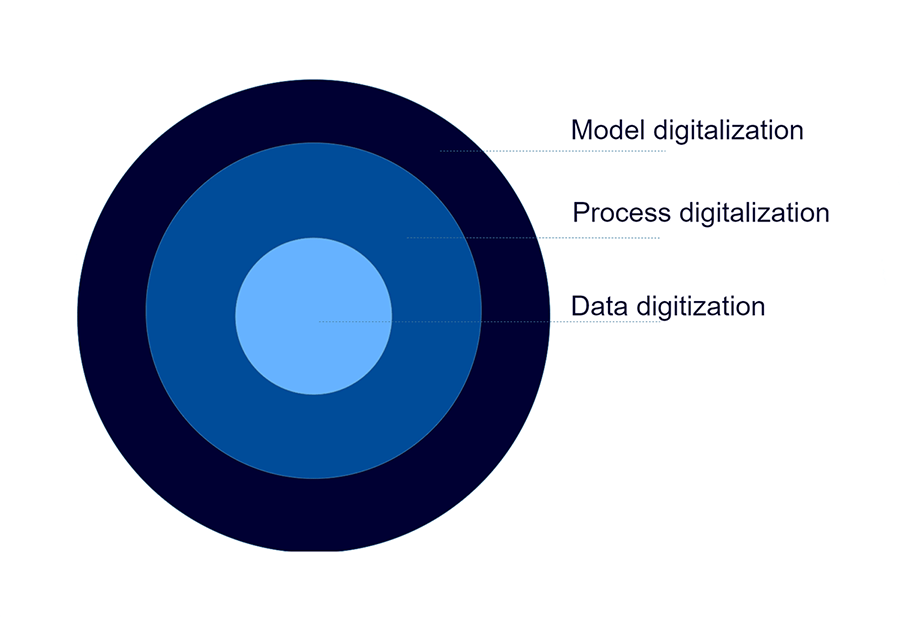
Digital transformation (DT) is the largest category, the complete model to bring businesses closer to the 4.0 digital economy. DT represents the whole process of digitizing data and digitalizing operating processes, business models. DT’s ultimate goal is people-orientation, and at the same time, combining the corporate culture with the customer-centric foundation. DT sets macro-objectives of people’s direction in building strategies, corporate culture, digital technologies, and adapting to these digital transformations.
Generally, most companies carrying out DT encounter significant barriers. They frequently ignore a complete data digitization plan while only focusing on refining more macro-plans in the process and model digitalization layer, which does not bring the high-volume transformation effect due to the initial preparing step not been done thoroughly.
Also, preliminary estimates of time and the limited budget will present a significant challenge for DT tasks in specific periods. Multiples of businesses are unable to catch the expected results. However, despite the existing challenges that they have confronted recently (the COVID-19 crisis), digital transformation will provide comprehensive support on data systems and digital platforms, exclude all social distances, and connect the world easily anytime.
The digital transformation process has made both efficiency and sales for numerous B2C and B2B businesses. In detail, ecommerce is the most typical manifestation, having recorded impressive growth since 2017. B2C companies have also strengthened the development of a more powerful ecommerce channel than ever.
Meanwhile, B2B models pay much more attention to transforming chains/systems/processes such as production or goods distribution processes by gradually turning into online methods to adapt to the flexibility and rapidity of the 4.0 supply chain.

Up to now, ecommerce can be considered as the complete performance of the digital transformation process. Ecommerce channels can update information quickly and continuously while also ensuring UI/UX optimization to provide perfect user experience, excellent customer experience, and as a result, increase sales. These are also the requirements to digitalize the markets and perfect the business’ operating system. Depending on the DT objectives, the company will stop at the stage that best suits its business model. Some of the businesses only need to digitize data for more effortless operation.
However, from a much more general perspective, almost all companies convert to an ecommerce system to control their business independently and connect directly with customers, partners and come closer to the DT outcomes. Those objectives are also the straightforward development orientation of most retailers today. They focus abundant resources on developing the ecommerce channel to expand the business scale.
For instance, The Coffee House is a case study of the F&B industry’s impressive DT outcomes in Vietnam. The brand has achieved their ordering application for more intensive data resource management and operation. This application was initially built on a requirement to increase the loyalty program’s ease and improve customer care service quality.
However, until now, this sales channel has grown more than that and has become a mainstream business channel that seamlessly integrates with the brand’s existing offline stores.

The TCH app aims to connect and interact directly with customers based on the D2C model, allowing app-users to create membership accounts to earn points and order quickly. These features allow brands to access customer data and shopping habits easily. In-depth data analysis will contribute to new product strategies or menu amendments to better suit the customer’s taste.
Digital transformation is a long-term journey that needs to be done with a detailed and complete strategy while meeting the time and budget, matching the current business’s capabilities. Digitization/digitalization layers also need to fully play their role in digital platforms, transforming entirely and efficiently. A complete ecommerce system considerations are also required for supply chains currently in the marketplace. Ecommerce will be the most agile driver of digital transformation; however, make sure that you can implement a strategy with the right priority in the current situation to give the best effect.
 2
2
 9,072
9,072
 3
3
 1
1
With no exception, brands transform as always to keep up with the digital age’s swift trends. To complete the digital transformation, investing in brand touchpoints is a concept that worth-considering. Most generally, the brand touchpoint is the simultaneous interference from both businesses and customers, creating the highest attraction for the business and providing the best customer experience.
However, some people argue that the concept of brand-touchpoint is vague and quite broad because any existing factors can potentially affect the movement of brand touchpoint for better or worse. This argument will be recognized if businesses do not know where to start creating a touchpoint. Brand touchpoints stem from business core-values, the level of customer experience, and a little bit of difference when needed.
System assets help businesses grow in both quantity and quality. A standardized system not only allows products to shape within the unified normative framework but also ancillary services. A complete digital transformation of a brand does not stop at the product level. Developing and continuously improving the system are the keys to meet the second requirement of the brand touchpoint: user experience. The apt system helps businesses get in touch with product-and-service convenience and can create an isolated ecosystem to make brands transform.

That was how Apple had been successfully producing a technology-product ecosystem that made a stunning attraction for users. Simply put, the term ecosystem in this context implies a group of products that can interact with each other in harmony to optimize customers’ convenience. Apple has generated an almost-efficient technology ecosystem that performs seamless interactions. However, what makes Apple enthusiasts completely satisfied is the personal ID system with high privacy and data security.
To take another example, Nike has wholly changed their business since their growth stalled, and the earlier business model was no longer sufficient. The mandatory change in the brand requirements has shifted to using an online business network to interact directly with consumers. The online trading system completely replaces the traditional product-distribution through intermediaries, as well as exclusive distributors. Nike also combines the accompanying member programs with trendy and fashionable items, creating a close connection with customers. As a result, the transforming system contributed to an increase in ecommerce revenue by 38% in November 2019 (data provided by Brands Vietnam).
To transform successfully in the digital age, make sure that the brand is honest and authentic. All information about the business can be delivered more quickly than ever in the internet era. A restaurant with a 1-star review will undoubtedly make customers turn away. Therefore, providing authentic information will make users feel secure and reliable when using products. Brand honesty helps create a pure life for products while contributing to the user experience’s seamlessness, making the brand touchpoint in harmony. Transparency in product quality and working manner will create a unique touchpoint system.
That viewpoint may sound strange, but most customers in the digital age need simpler products, services than cumbersome and complicated ones. Simplicity and minimalism in branding still can create brand touchpoints while focusing on the pillar values of the brand, such as strengths, target customers, differentiation, missions, quality, and messages. These keys, eliminating other complex elements, will be more focused and orientated for businesses in the long run. Simplicity and minimalism make businesses quickly adapt to the ever-changing digital age.

Product-centric is still an essential factor in most campaigns. However, customer-centric will be the necessary combination to enhance user experience, which making brands transform. Products exist in the world with the ultimate goal of meeting customer needs. Therefore, identifying customer needs is a crucial starting point for a digital transformation campaign.

That is how the Maggi brand cleverly introduces cuisine recipes combining with soy-sauce on their website. This action increases convenience for cooking lovers. Customers feel more excited when their everyday-cooking gets more of the brand-attention though buying only one soy-sauce bottle.
In general, customer-centric is a long-term transformation requiring businesses to have a proper awareness of their target customers. This awareness should also form in every staff of the company to make brands transform. Besides, this customer-in-center philosophy acts as a value connecting businesses with their customers; but not a task to be completed and to get rid of.
The digital age witnessed rapid and unpredictable changes requiring businesses to have timely adaptive solutions. Products are not only produced for quality but for customer convenience. Other customer needs are also considerable except for products themselves, namely membership programs, accompanying promotional gifts. Customers also tend to shop more on ecommerce websites, which leads to a requirement to manage information, data, and technology platforms. Epidemics also become dangerous, increasing unforeseen risks for businesses.

Utilizing the challenges will be sure leverage when brands transform into the digital age. Besides, people are still the critical factor, no matter how advanced technology is. Therefore, businesses first need to focus on the internal structure: human resources, processes, products, and customer services to complete the transformation.
The COVID-19 crisis has globally worsened since the Government issued a social-distancing-order as the number of confirmed coronavirus cases continues to increase. However, recently, the ecommerce industry has had a speedy growth, as people now prefer to shop online while staying home. This time is much higher challenging for every business in Vietnam and an opportunity to make brands transform themselves.
At SECOMM, we will accompany clients on every ecommerce step to ensure comprehensive solution-providing for their ecommerce transformation. The brands transform successfully in a digital age when they are operated with a sustainable website platform. We will be the starting point for this revolution. Contact Us for more detail.
 2
2
 5,183
5,183
 22
22
 1
1Subscribe to get the latest eBook!
Hotline